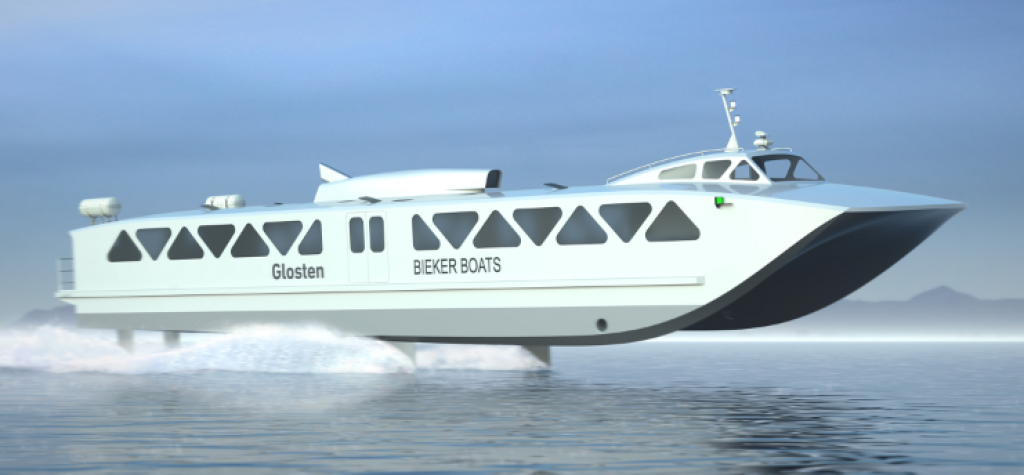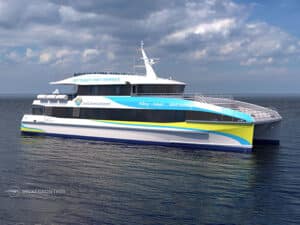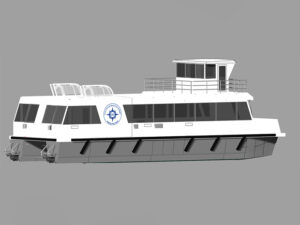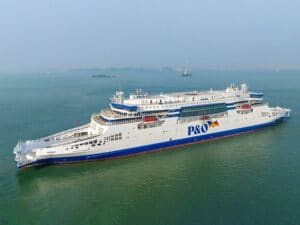
Passenger ferry designers look ahead
Written by Nick Blenkey
Foil ferry design being developed by Washington State project features composites hull, hydrofoils and electric drive option. [Glosten]
Electric Drives and Composites Proven in Europe
In Norway, where many short routes essentially fill in gaps in highway systems, battery-hybrid and all-electric ferries have started to become an every day reality helped along by government subsidies of one kind or another. Now routes served are getting longer, though here the lead is probably held by Denmark, where the e-ferry Ellen—selected as our Vessel of the Month in August—has been successfully operating on a 22-mile route for more than a year now. That lead may not last for long.
Back in Norway, shipbuilder Brødrene Aa, which specializes in lightweight carbon fiber sandwich catamaran hulls, recently delivered the Rygerelektra, a 297-passenger all-electric vessel measures 42 meters in length and is capable of 23 knots. At full passenger capacity, it will have an operational range of 50 nautical miles at a speed of 17 knots and will use less than 70% of its 2 MWh battery capacity between charges at this speed. Undoubtedly, the weight savings from the composite hull make a big contribution here.
A Unique Approach to Hydrofoils
Back in Washington State, meantime, the All American Marine yard is currently completing construction of the hydrogen fuel-cell powered e-ferry Water-Go-Round, which promises to pioneer a path to another future solution for green ferries. All American is, of course, well known as the only U.S. builder of vessels using the unique designs developed by Nic de Waal of Teknicraft Design, in Auckland, New Zealand. The unique Teknicraft design incorporates the use of a cutting-edge hull shape and an optional hydrofoil system in catamarans to create lift and enhance the performance of the vessel in Auckland.
Teknicraft says that the key to its proven hull design lies in the use of an asymmetrical hull shape, with essentially vertical tunnel sides between the catamaran hulls combined with semi-circular parabolic hull curvature, and most importantly, the employment of a hydrofoil support system. The hydrofoil is designed to provide just the right amount of lift, such that the catamaran demi-hulls are partly above the surface of the water, but not to the extent that seakeeping is compromised. The submerged part of the hull at service speed is essential to ensure high-speed stability and soft ride.
Externally, Teknicraft vessels don’t look like that conventional idea of “a hydrofoil” that rides up above the water supported on the foils like the Boeing Jetfoils deployed by the U.S. Navy back in the early 1970s. The Teknicraft hydrofoil is subtler than that.
All American Marine explains it like this: “Our unique hydrofoil system consists of the main foil spanning the tunnel at the keel, forward of the center of gravity position and two cantilever-type stern foils. The lift produced by the hydrofoil reduces the hull resistance, while increasing speed and load-bearing capability.
“The stern foils create a vertical lift at semi-planing speed, which reduces the trim angle when getting on step. This significantly reduces both the power requirement and the wake wash in the low-speed range. The main foil action reduces the power needed to maintain service speed; therefore, fuel consumption and running costs are reduced significantly, while also further enhancing the softness of the ride, especially in choppy seas. We have years of experience testing and building both aluminum and composite adjustable hydrofoils, depending on the application of each vessel and where appropriate.”




